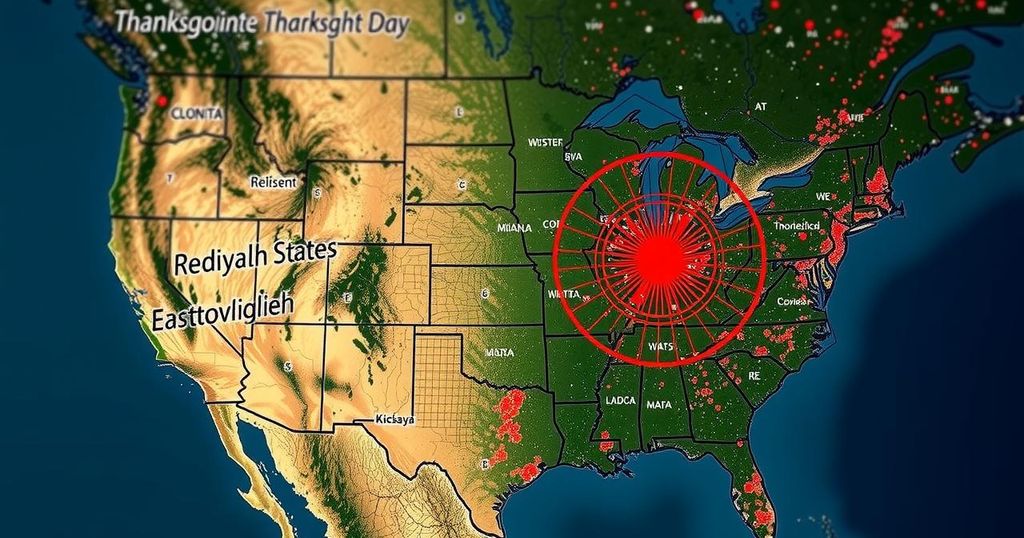World news
AFRICA, ARKANSAS, CANTON, EARTHQUAKES, EVACUATIONS, JACKSON, LOUISA VIRGINIA, MISSISSIPPI, MISSISSIPPI RIVER, NATURAL DISASTER, NATURAL DISASTERS, NEW MADRID, NEW MADRID SEISMIC ZONE, NM, NMSZ, NORTH AMERICA, RICHMOND, RIDGELY, SHALLOW EARTHQUAKE, SOUTH AFRICA, STRAWBERRY, TENNESSEE, UNITED STATES, US WEST COAST, USGS, VIRGINIA
Fatima Khan
0 Comments
Thanksgiving Day Earthquakes Shake Eastern U.S.: A Reminder of Potential Risks
On Thanksgiving Day, minor earthquakes were reported across Virginia, Mississippi, Tennessee, and Arkansas, with the strongest being a 2.5 magnitude quake in Mississippi. While no damages occurred, experts stress the need for better preparation for future significant seismic events, particularly in the historically active New Madrid Seismic Zone, where a more powerful quake is expected at some point.
On Thanksgiving Day, the eastern United States experienced a series of minor earthquakes, according to reports from the United States Geological Survey (USGS). The most significant event was registered in Mississippi, where a magnitude 2.5 quake occurred, while others in Virginia, Tennessee, and Arkansas measured below magnitude 2.5. Despite some residents reporting rattling or a loud boom, there were no reported damages or injuries from these seismic events, suggesting that they were too weak to cause harm.
The earthquake timeline began just before midnight when a magnitude 1.8 tremor hit central Virginia, near Louisa, at a shallow depth of 0.3 kilometers. The Mississippi quake followed in the early morning hours, occurring at 1:48 AM near Canton, deeper at 5 kilometers. Additional tremors struck western Tennessee starting at 4:23 AM, with subsequent quakes occurring rapidly until 5:08 AM, all within the New Madrid Seismic Zone at depths ranging from 5.9 to 6.1 kilometers. An additional 2.1 magnitude quake affected Strawberry, Arkansas, around the same time.
Although the earthquakes were relatively inconsequential, experts warn that preparedness in the region for potentially devastating seismic events is inadequate. The area, particularly Tennessee, is situated within the New Madrid Seismic Zone (NMSZ), known for its historical violent earthquakes. The possibility of a more substantial quake is largely seen as a matter of “when” rather than “if.”
Historically, the NMSZ has experienced devastating quakes, with the last significant series occurring between December 1811 and March 1812. The first of these, recorded at 8.1 magnitude, caused substantial shaking across the eastern U.S. and was felt as far as New York City and Charleston, South Carolina. Subsequent major events included quakes of magnitudes 7.8 and 8.8, resulting in significant destruction and loss of life, though full impacts remain difficult to quantify due to the era’s limited scientific capabilities.
The earthquakes generated peculiar phenomena: reports of seismoluminescence, heated waters, and what residents termed “earthquake smog”. These effects were attributed to geological forces, suggesting that such strange occurrences could accompany future quakes, underscoring the unpredictable nature of seismic activity in this historically active region.
Given the current population density in the NMSZ, the potential for catastrophic outcomes during the next major quake is heightened, further emphasizing the need for improved public awareness and preparedness regarding seismic risks.
The New Madrid Seismic Zone is a historically significant area in the central United States, noted for its series of powerful earthquakes during the winter of 1811-1812. These events reshaped the understanding of seismic activity in the region and highlighted the potential for future devastating quakes. Contemporary awareness and preparedness for such natural disasters remain critical as millions now inhabit areas vulnerable to significant ground shaking. Despite advances in scientific understanding, predicting the exact timing and impact of future earthquakes continues to pose challenges.
In summary, the Thanksgiving Day earthquakes across Virginia, Mississippi, Tennessee, and Arkansas have served as a reminder of the seismic risks present within the New Madrid Seismic Zone. While these recent events were minor and did not cause any damage, the historical context suggests that the region remains vulnerable to major earthquakes. Thus, it is imperative to increase public awareness and preparedness strategies to mitigate potential future hazards, as experts continue to emphasize that a significant earthquake is likely to occur in this area again.
Original Source: weatherboy.com




Post Comment